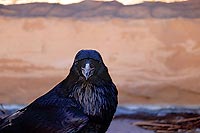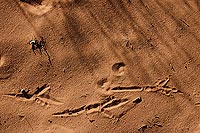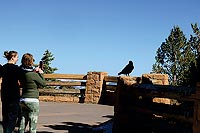 Common ravens are very vocal birds known to make over 100 sounds and can even imitate human voices. From whistles and shrieks to the harsh “Crock!” call, ravens make their presence known in Canyon Country. And apologies to Edgar Allen Poe - the word “nevermore” is not part of their vocabulary.
Common ravens are very vocal birds known to make over 100 sounds and can even imitate human voices. From whistles and shrieks to the harsh “Crock!” call, ravens make their presence known in Canyon Country. And apologies to Edgar Allen Poe - the word “nevermore” is not part of their vocabulary.
Because of this repertoire of sounds and their cunning behavior, ravens have been held in high regard by numerous cultures from Native Americans to Northern Europeans. Often depicted as mischievous, thoughtful, or as a trickster, ravens hold a special status within the avian and human world.
In southern Utah, ravens are year-round residents and they occupy just about every habitat type from open desert to canyons to high up in the mountains. At home in the wild or close to developed areas such as farms, ranches, and residential neighborhoods, ravens, and their close relatives the crows, are common sights.
Historically, ravens were abundant across North America but heavy logging in eastern hardwood forests during the 19th and 20th centuries reduced the bird’s populations. Today, the birds are reoccupying some of those hardwood woodlands as the forests regenerate. 
Across their range, ravens are omnivorous, eating everything from roadkill to insects and even manure. They aren’t predatory like hawks and often feed on eggs, seeds, fruit, or dead animals and fish. They are a part of Nature’s clean-up crew which includes other members of the Corvid family - crows and magpies.
Ravens may also cache food for later consumption and have been known to use “tools” such as small sticks to access food hidden in recesses or to dig out insects. Ravens are also known to take advantage of unattended campsites and tear apart food bags or raid open daypacks in search of a snack.
During the breeding season, ravens utilize old nests or build new ones with a collection of sticks and a deep inner bowl lined with animal fur, hair, grasses, or shredded bark, The birds construct these nests in a cliff crevice, a tree crotch, or atop the cross bars on a power pole or maybe a bridge abutment. Sometimes great horned owls or red-tailed hawks may usurp these nests for their own. Three to seven eggs, which might have a green or bluish cast, are laid in late spring and the young fledge anywhere from 26-50 days old. 
In flight, ravens engage in aerial maneuvers that anthropomorphically suggest they are having a good time. The birds catch updrafts, do barrel rolls, swoops, or even fly upside down. A game of “chase” sometimes erupts over a stick or bit of animal carcass and gives a new meaning to catch and release! This social interaction may build relationships for later times when the birds gather at a carcass. Their antics make it hard not to believe that the birds are just enjoying themselves.
In the fall, ravens may gather in flocks, known as an unkindness of ravens (which is better than a murder of crows). The flocks may signal to each other about food resources, a trait that benefits the group over the individual. As other species begin their fall migration, ravens stay home or move short distances depending upon food resources. This time of year offers a great opportunity to watch and listen to these charismatic creatures of the Canyon Country…and maybe learn a little “raven speak” in return.